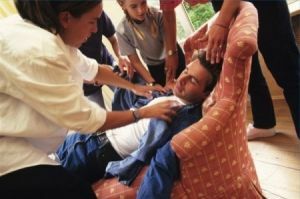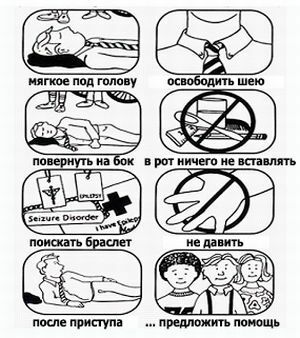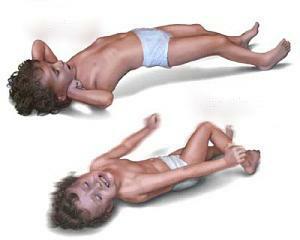 Epilepsy is a chronic disease that manifests as seizures, seizures of associated with impaired perception of the outside world( vision, smell, hearing), reactive( speech) and motor( uncontrolled, inconsistent gestures, numbness of limbs or body).
Epilepsy is a chronic disease that manifests as seizures, seizures of associated with impaired perception of the outside world( vision, smell, hearing), reactive( speech) and motor( uncontrolled, inconsistent gestures, numbness of limbs or body).
Loss of consciousness is also possible( as a sudden attack or consequence of several seizures in a fairly short period of time).
Epilepsy does not always begin immediately with intimidating tonic-clonic seizures( screams, convulsive flinches, tilting of the head, incomprehensible sounds).This form of epilepsy can develop gradually.
Despite the range of possibilities of modern medicine, it is not always possible to completely cure this disease or even to reveal its causes.
Contents of
- What types of seizures are most common to people
- The danger of untimely or improper care in case of an attack
- First aid
- How to recognize an approaching attack?
- Preparing for a seizure
- How to help a person during an attack
- What to do after an attack
- When to call an ambulance
- Video: First aid for epilepsy
What types of seizures people face most often
Attacks are:
- obvious, recognizabletonic-clonic seizure, complex focal disorders);
- less noticeable( aura, absences. ..).
Less obvious seizures may not cause a reaction from others, because they can be confused with the characteristics of human behavior( look at one point, do not answer the question - thought, sudden change of mood - it is also possible).
Not so dangerous and seemingly symptoms can be a sign of an approaching serious attack( as an aura).Or they can proceed independently, without provoking complications.
In any case, if a mild form of epilepsy( or suspicion) occurs, person should be shielded from all negative external factors ( noise, cold, heat), do not try to restrain him in actions, help him to settle comfortably.
Whatever the causes of an epileptic attack, first aid should be given promptly and correctly.

Risk of untimely or improper care in case of an
attack. As you understand, we are talking about complex focal or generalized epileptic seizures( with pronounced muscular activity and respiratory failure).
The following dangerous events are possible:
- ingestion of saliva, blood, food into the respiratory canals;
- hypoxia( due to respiratory problems);
- further disruption of the brain;
- coma( with prolonged epilepsy);
- death.
First aid
First aid for an epileptic seizure is of paramount importance and can save a person's life.
How to recognize an approaching attack?
If you know that a person has previously suffered epileptic seizures, then the following signs will indicate the next danger:
- increased nervousness, irritability;
- violation of habitual biorhythm: hyperactivity or excessive drowsiness;
- lack of response to others;
- dilated pupils;
- sometimes causes anxiety and tearfulness.
 How does Huntington's chorea manifest itself and is it possible to alleviate the patient's life? Learn the details of our article.
How does Huntington's chorea manifest itself and is it possible to alleviate the patient's life? Learn the details of our article.
Why the treatment of leptospirosis in humans should be started at the very beginning of the disease and what prevention methods exist.
Preparing for a seizure of
If you suspected an approaching problem, you must make the the following:
- clean around all objects that can be dangerous in case of a complex fit( sharp objects, electrical appliances);
- try to provide the patient with physical and psychological comfort;
- Ask the person if he has experienced epileptic seizures( if you do not know), offer your help;
- ask simple questions - to test the reactive capability;
- free the neck from the pulling clothes( tie, shirt);
- put something soft under your head;
- provide sufficient space for the room.
How to help a person during an attack of
At the first symptoms of epilepsy, timely first aid is very important. Everyone should know how to help in such cases:
- Do not be afraid of foam from the mouth, seizures. The life of a person can depend on your concentration and ability to react.
- Remove or loosen the pulling clothes( tie, tight jacket or pants, tight belt).
- Try to turn the person's head sideways( without applying significant physical effort!).Hold your head, if possible( so that saliva and tongue do not interfere with breathing).
- Do not try to hold the epileptic force in a certain position, you can pierce it.
- If the epileptic has jaws closed, do not open them. From this action, it makes no sense, and it is unlikely that you will succeed.

- Do not let him drink.
- Put something soft under your head.
- If the mouth is ajar, insert some object in it, not very hard - a folded handkerchief, for example( to prevent biting the tongue).
- If breathing has stopped - do not panic. This is usually a temporary phenomenon. However, just in case, check the pulse.
- In case of involuntary urination, cover the patient below the waist with some clothes or polyethylene( so that the smell does not become an additional irritant).
- If the seizure site is safe for the life of the epileptic( it's not water, the edge of the cliff or the road), do not move it to another location. However, in the opposite case, be sure to transfer the patient, taking his armpits and pulling him over the upper part of the torso.
- Do not perform artificial respiration or cardiac massage.
- The resuscitative measures specified in paragraph 12 will be needed if the attack occurred in the water and the patient's breathing pathway gets water.
- Do not try to give medication, anyway they will act at least in half an hour.
What to do after an attack of
A tonic-clonic or strong focal attack ends when the muscles of the epileptic have come to a normal state and the one shows the first signs of consciousness.
Less often, the end of the attack is accompanied by a relaxation of the bladder( urination), and the reaction to the outside world is missing for some time.
What needs to be done after the is completed:
- Try to put the relaxed body of the patient on its side( so that the root of the tongue does not fuse).
- Politely ask to disperse the accumulated people( for psychological comfort).Those who are able to help in case of a seizure or before the arrival of a doctor remain with the patient.
- Sometimes, when small twitchings of the body or limbs are still observed, the person tries to stand up: try to hold it while walking. If you are in a high-risk area, try to keep the epileptic recumbency until complete cessation and recovery of consciousness.
- Usually, for absolute normalization of the state, it takes 10-15 minutes.
- After the return of consciousness, the person himself can decide whether he needs medical help. Some people know the specifics of their disease thoroughly and are aware of what to do.
- Do not attempt to give the affected medications, if this is not the first attack - he certainly has a special prescription from the doctor, and if the first - it requires a thorough diagnosis before you pick up the necessary treatment.
- After an attack, it is desirable to avoid taking caffeinated beverages, spicy seasonings, marinades, savory - these products provoke excitability of the nervous system.
- Very often, after an attack, the epileptic tends to sleep. Provide all necessary conditions.
In some cases it is necessary to call an ambulance
If first aid provided for epilepsy, but there are circumstances that may confuse you, you should call an ambulance :
- seizure occurred with a pregnant woman;
- attack lasted more than 3 minutes;
- the problem occurred with an elderly person or child;
- during the seizure was injured;
- is the first for the last 5 years or for a lifetime attack;
- in case of remission of the condition;
- breathing is heavy, difficult after a fit;
- the patient does not regain consciousness;The
- attack occurred in the water.
First, everyone should know how to help in case of a seizure. You may encounter this problem at any time. The doctor can not always be found immediately.
Secondly , it is very important to treat epileptics, as well as to other people - without excessive trepidation and apprehension. People who are prone to epileptic seizures are full members of society.
Your task is to help them if necessary.
Video: First aid for epilepsy
How to help the victim, if you are sure that he had an attack of epilepsy. What not to do in any case?



